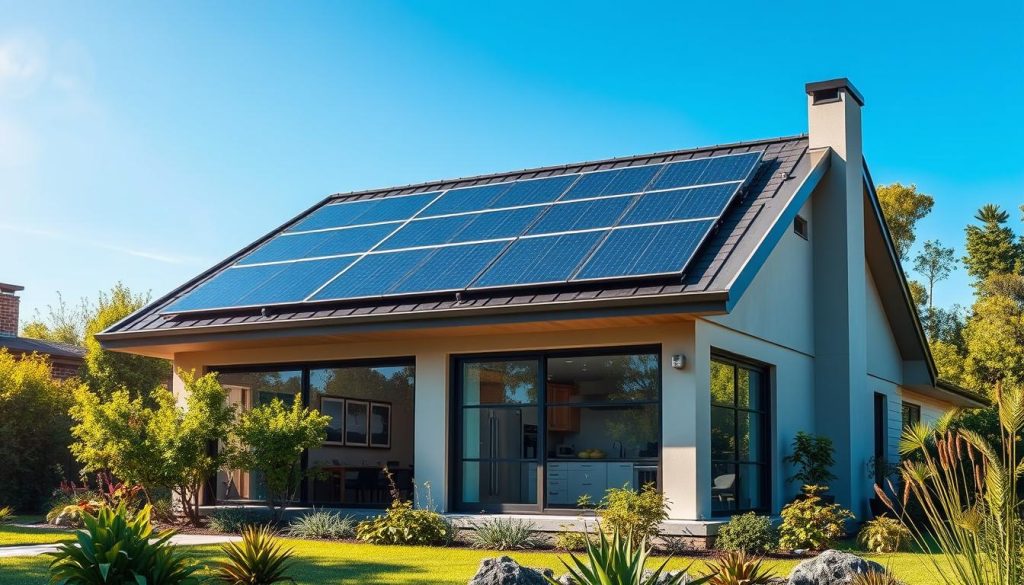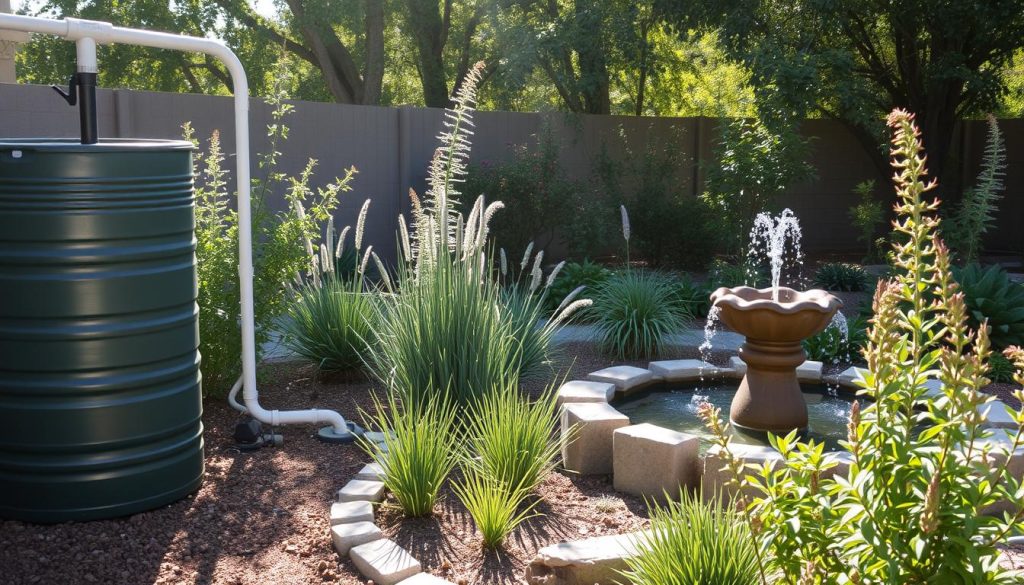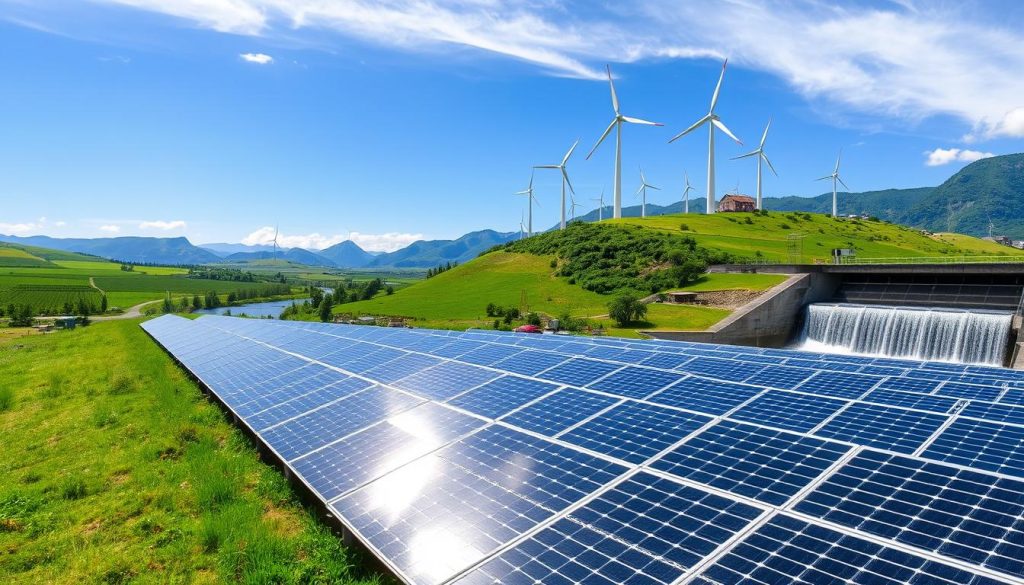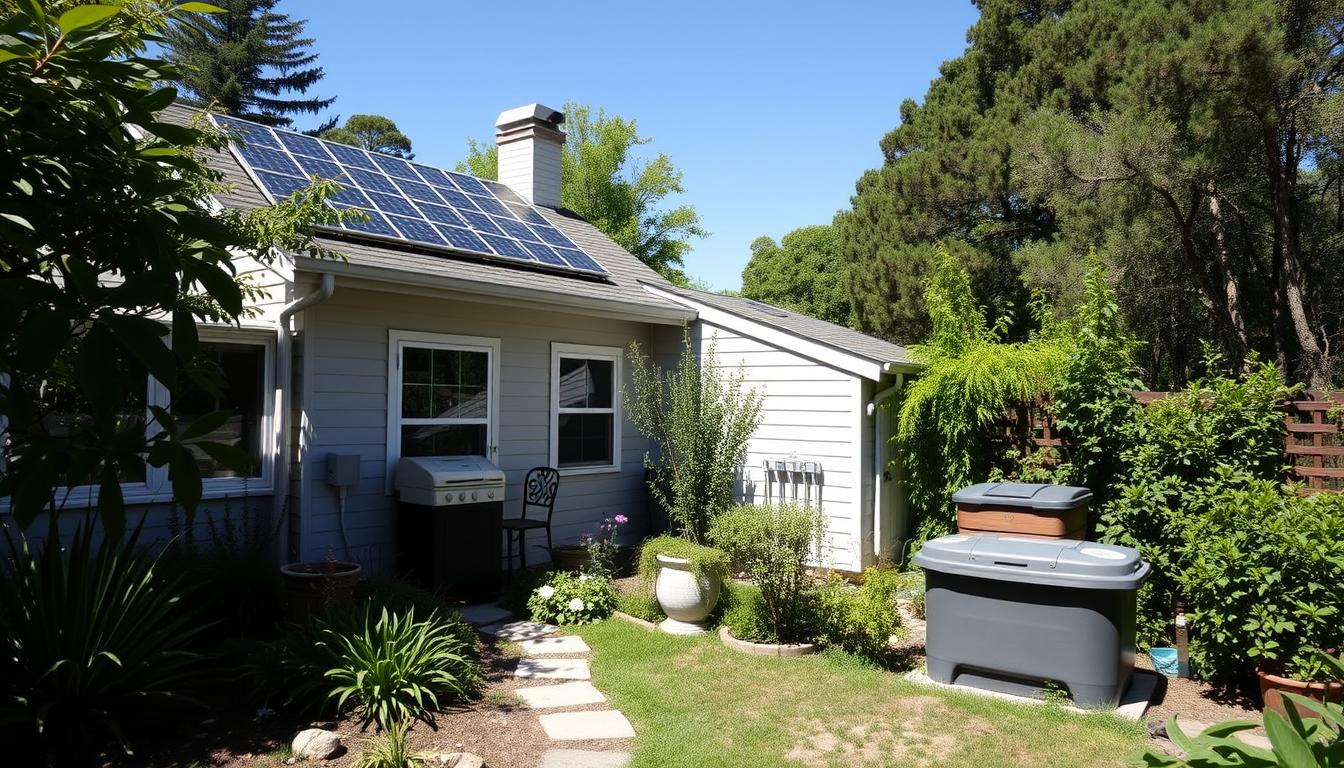As an eco-conscious homeowner, I’m excited to share my journey to sustainable living. This guide will show you how to lower your carbon footprint, save money, and live greener. We’ll cover energy-efficient appliances, renewable energy, water saving tips, and waste management.
Switching to sustainable home utilities might seem hard, but it’s worth it. Small changes can make a big difference. Let’s explore eco-friendly home tech, renewable energy, and ways to save water and reduce waste. Together, we’ll make your home a green oasis.
Why Choose Sustainable Home Utilities?
The world is waking up to the need to protect our environment. Choosing sustainable home utilities is now a key choice. It’s not just a trend; it’s a way of life that benefits both the planet and your wallet. By using eco-friendly energy and renewable resources, you help create a greener future. Plus, you get to enjoy the many perks of sustainable living.
Understanding Sustainability
Sustainability means meeting our needs without harming future generations. For home utilities, this means using renewable energy, managing water wisely, and reducing waste. By living sustainably, our homes can work in harmony with nature. This reduces our carbon footprint and saves valuable resources.
Benefits of Eco-Friendly Utilities
- Reduced energy costs and utility bills
- Smaller carbon footprint and contribution to a healthier planet
- Access to tax credits, rebates, and other financial incentives for sustainable home upgrades
- Increased property value and appeal for eco-conscious buyers
- Improved indoor air quality and overall well-being
My Personal Sustainability Journey
My journey towards sustainable living started a few years ago. I realized our household’s impact on the environment. I wanted to make a change and started looking for ways to use less energy and water.
Installing solar panels and using water-saving techniques was rewarding. I’ve seen our utility bills drop and learned to value sustainable living. It’s a journey I’m proud of, and I believe it can benefit everyone and the planet.
Energy Efficiency in the Home

Living sustainably means making our homes more energy-efficient. We can do this by picking energy-saving appliances, using smart home tech, and looking into solar power. These steps help make our homes greener and more eco-friendly.
Choosing Energy-Efficient Appliances
Choosing the right appliances is key. Look for ones with the ENERGY STAR® label. These appliances save energy and cut down on your bills over time.
Smart Home Technology for Efficiency
Smart home tech changes how we use energy. It includes smart thermostats and lighting controls. These tools help us use less energy and save money.
My Experience with Solar Energy
Getting solar panels was a game-changer for me. They let me make my own clean energy. It’s cut my bills and made me feel more independent.
Water Conservation Techniques

Creating a sustainable home is important, and water conservation is key. There are many ways to use less water and help the planet. Let’s look at some effective methods for saving water in our homes.
Installing Low-Flow Fixtures
Installing low-flow fixtures is a simple yet powerful way to save water. These showerheads, faucets, and toilets use less water but still work great. Replacing old fixtures with new ones can save thousands of gallons of water each year.
Rainwater Harvesting: Is It Worth It?
Rainwater harvesting is another interesting way to save water. It involves collecting and storing rainwater for irrigation and some indoor uses. While it costs money upfront, it can save a lot of water and money in the long run. It’s important to think about if it’s right for your home and budget.
My Favorite Water-Saving Tips
- Regularly check for and repair any leaks in your plumbing system to prevent unnecessary water loss.
- Implement a water-efficient landscaping approach, such as using drought-resistant plants and implementing smart irrigation systems.
- Educate your family on simple water-saving habits, like turning off the faucet while brushing teeth or taking shorter showers.
By using these water-saving tips, we can help protect this valuable resource. Every bit of water we save helps our planet. Let’s work together for a more sustainable future.
The Role of Renewable Energy

Using renewable energy is key to a sustainable future. It helps us use less fossil fuels and cut down on carbon emissions. We’ll look at different renewable energy options and how to use them at home.
Types of Renewable Energy Sources
Renewable energy is plentiful, naturally replenished, and good for the planet. Some common types include:
- Solar power systems: Use the sun’s energy to make electricity with photovoltaic panels.
- Wind turbines: Make clean electricity from wind.
- Hydropower: Use water flow, like from rivers and dams, to generate electricity.
- Geothermal energy: Use the Earth’s heat for home heating and cooling.
- Biofuels: Get energy from organic, renewable sources like plant waste or energy crops.
How to Transition to Renewable Energy
Switching to renewable energy might seem hard, but it’s doable. Here are some steps to help:
- Figure out your energy needs and how much you use to pick the right renewable energy for your home.
- Look into different renewable energy providers and technologies to find what works best for your budget and needs.
- Check out incentives, tax credits, and financing options to make going green cheaper.
- Talk to local experts and renewable energy specialists for help with installation.
- Learn about renewable energy and how to use it in your daily life with your family.
My Journey to a Renewable Home
My journey to a sustainable home started with renewable energy. I chose to put solar panels on my roof. The process was easy, and I got help with costs through incentives and tax credits.
Now, a lot of my home’s electricity comes from the sun. This has cut my carbon footprint and utility bills. It’s been a rewarding change, and I’m happy to help make the future greener.
Sustainable Heating and Cooling Solutions
Keeping our homes at a comfortable temperature is key. But, traditional heating and cooling systems can be expensive and bad for the environment. Luckily, there are green options that help us save energy and money.
Choosing Energy-Efficient HVAC Systems
For heating and cooling, choose energy-efficient appliances. Look for ones with the ENERGY STAR® label. They use less energy and cut down on your bills. These systems also make your home more eco-friendly.
My Experience with Geothermal Heating
Geothermal heating and cooling is a cutting-edge, green choice. I switched to it in my home and it’s been a game-changer. It uses the Earth’s heat for efficient heating and cooling, saving a lot of energy and money. The setup was easy, and the long-term savings are huge.
Utilizing Ceiling Fans Effectively
- Ceiling fans are a simple and effective way to enhance the efficiency of your heating and cooling system.
- By strategically placing and using ceiling fans, you can help circulate the air and evenly distribute the temperature throughout your home.
- In the summer, running ceiling fans in a counterclockwise direction can create a cooling breeze, allowing you to set your thermostat a few degrees higher and save on energy costs.
- In the winter, reversing the fan’s direction to clockwise can help push warm air down, reducing the workload on your heating system.
By using these green heating and cooling solutions, you can enjoy a cozy home. You’ll also cut down on your environmental impact and save on bills. It’s good for you and the planet!
Waste Reduction Strategies
In our quest for sustainable living, cutting down on waste is key. By using smart strategies, we can greatly reduce household waste. This helps us live more eco-friendly lives.
Composting at Home
Composting is a top way to cut down on waste. It turns organic waste into soil for our gardens and plants. It’s a simple, rewarding process that fits into our daily lives.
Recycling Tips and Tricks
- Sort and segregate recyclables properly to ensure they are processed correctly.
- Explore local recycling programs and stay informed about the materials they accept.
- Reduce the use of single-use plastics by opting for reusable alternatives whenever possible.
My Success with Zero-Waste Living
I’ve made big steps towards a zero-waste lifestyle. Through composting, recycling, and finding new uses for items, we’ve cut down waste a lot. It’s a journey, but feeling good about helping the planet makes it worth it.
Eco-Friendly Landscaping Options
Sustainable home utilities are not just for indoors. Outdoor landscaping is key to an eco-friendly lifestyle. Choosing sustainable landscaping options can make your property beautiful and help save water and the environment.
Native Plants and Their Benefits
Native plants are a big part of eco-friendly landscaping. They fit well with local weather and soil, needing less water and care than other plants. Using native plants makes your garden beautiful, easy to care for, and helps local wildlife and saves water.
Creating a Sustainable Garden
- Incorporate drought-tolerant plants: Choose plants that thrive in your local climate and require minimal watering, such as succulents, cacti, and native grasses.
- Implement water-efficient irrigation: Install drip irrigation systems or use soaker hoses to deliver water directly to the roots, reducing evaporation and waste.
- Utilize mulch: Spread a layer of organic mulch around your plants to retain moisture and suppress weed growth.
- Compost and recycle: Create a compost pile to reduce waste and improve soil health, and explore ways to recycle water, such as through rainwater harvesting.
My Journey to a Drought-Resistant Yard
I live in a dry area and wanted a sustainable yard. I replaced my water-hungry lawn with native plants and got efficient irrigation. This cut down my water use and made a garden that’s good for wildlife and looks great. It’s been a rewarding change, and I’m eager to find more ways to green up my yard.
Community and Sustainable Utilities
Being eco-conscious at home is more than personal choices. It’s about working with the community too. By supporting local green projects and connecting with others, we can make a bigger difference. We can also encourage more people to live sustainably.
Supporting Local Green Initiatives
Getting involved in local eco-friendly efforts has been rewarding. I’ve joined community workshops, helped with clean-ups, and pushed for green energy policies. These actions have helped me understand and tackle local sustainability challenges.
Connecting with Like-Minded Individuals
Being around people who care about the planet has changed my life. I’ve found support and new ideas through online groups and local events. We share tips, celebrate our wins, and stay motivated to live more sustainably.
My Role in Promoting Eco-Living
I love sharing my sustainable living journey with others. I’ve hosted workshops, organized tree-planting events, and talked about my solar panels. My goal is to inspire and help my community live more eco-friendly. By doing so, we can build a greener, stronger society together.

